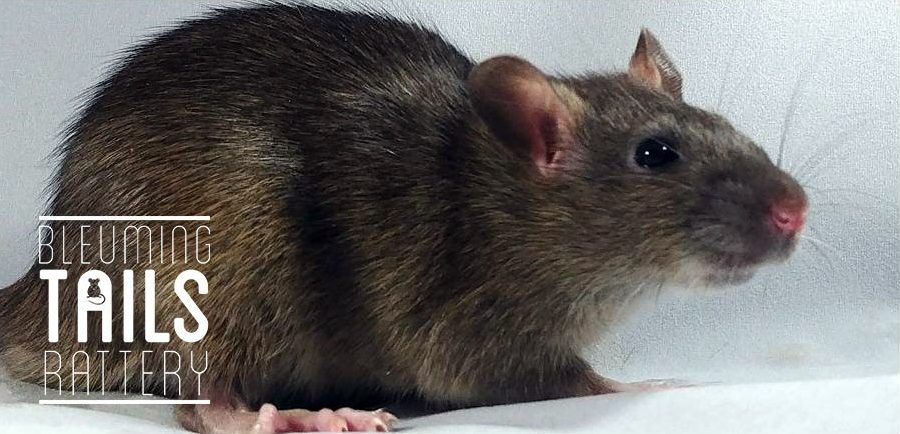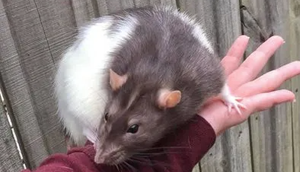The Plush Perfection of Velveteen Rats
Exploring the Velveteen Coat Type in Rats: What You Need to Know
If you’ve ever admired the soft, luxurious fur of a rat and wondered about the different types of coats they can have, you’re in for a treat. One of the most fascinating and sought-after coat types in the rat world is the Velveteen coat. At our rattery, we’re excited to confirm that we now have Velveteen rats in our breeding program, and we can’t wait to share all the details about this unique and stunning coat variety.
The Velveteen coat is characterized by its dense, wavy curls that set it apart from other curly-coated varieties. Unlike the Rex coat, where the curls tend to clump together, Velveteen curls are more defined and separate, giving the coat a softer, more plush feel. While the fur is dense, it doesn’t get overly thick or coarse. The overall texture is soft and velvety, much like the fabric it’s named after.
As babies, Velveteen rats look like little lambs with a fluffy coat, but as they mature, the fur softens and the curls lose some of their tight wave, though they remain full and thick. Around the time of the five-week molt, the coat may lose a bit of its wave, but it will still maintain its density. One thing to note is that when Velveteen rats inherit two copies of the gene, they don’t lose hair like Rex rats but instead develop a thicker, plusher, and more curly coat. Velveteen rats are known for their long, forward-curved whiskers.
The Velveteen gene is often associated with the Curly-1 or Curly-2 gene variations on chromosome 5, leading to the genotype “Cucu” being used for the variety. Velveteen is an incomplete dominant gene, which means it only takes one copy to produce the distinct coat, but will exhibit a third phenotype when the gene is doubled. While it’s not yet standardized or widely recognized in breeding registries like AFRMA, many breeders who work with the variety.
To understand the Velveteen coat, it’s helpful to compare it to the more common Rex coat. Both the Velveteen and Rex coats are curly-type coats and are known as rexoids, but there are key differences between the two:
- Velveteen Coat: The Velveteen coat is softer and more plush. The curls are more tightly defined, and the overall feel is smoother and velvety to the touch. The fur is dense but often shorter than the Rex coat, and the curls are finer. The Velveteen gene is an incomplete dominant, meaning that if a rat inherits one Velveteen gene, it will have the velvety texture, but if it inherits two, the fur will be short and dense, resembling a freshly shorn sheep.
- Rex Coat: Rex rats also have curly fur, but their coat has a rougher texture with looser curls. The Rex gene is also an incomplete dominant, but it behaves differently than Velveteen. While a single copy of the Rex gene results in a curly coat, a rat with two copies of the Rex gene (homozygous) typically develops a sparse coat, sometimes even becoming completely hairless. This is due to the way the Rex gene affects the hair follicles, causing them to produce less hair overall.
When it comes to confirming a new coat type or genetic variety, breeders often rely on a method called test breeding. Test breeding is a systematic process used to verify the genetic traits of rats and distinguish one variety from another, especially when it comes to similar traits like the Rex and Velveteen coat types.
In the case of Velveteen, the only surefire way to differentiate between this unique coat and the more common Rex coat is by observing how the coat type behaves when the variety is doubled. Both Rex and Velveteen are incomplete dominant genes, which means that if a rat inherits one copy of the gene, it will exhibit the curly coat. However, the way the coat behaves when the gene is doubled (homozygous) is what makes them distinct.
For a Rex rat, when it inherits two copies of the Rex gene, the coat typically becomes much curlier and can even lose hair in some cases, resulting in a sparse or patchy coat. On the other hand, when a Velveteen rat inherits two copies of the Velveteen gene, the coat doesn’t lose hair. Instead, it becomes even thicker, denser, and more curly, while maintaining its soft and plush texture. This is the key distinguishing factor between the two coat types, and it’s only observable after breeding and letting several generations grow out.
Test breeding is a multi-step process that typically takes several generations and months of waiting to confirm. The first step is to start with a foundation pair of rats, one that carries the Velveteen gene (or is suspected to carry it) and another rat that may carry the same or a different coat gene, such as a standard coat or Rex. These rats will produce the first generation (G1) of offspring.
After these rats mature, breeders will selectively pair them with other rats from different lines to observe how the traits manifest in future litters. The goal is to create Generation 2 (G2), which refers to the second generation of offspring that are two generations past the foundation pair. By this point, the genetic traits from the initial breeding begin to become more consistent, and the breeder can better understand how the Velveteen coat behaves across generations.
In the case of Velveteen, breeders are specifically looking for how the coat doubles. A G2 litter may include some rats with more pronounced velvety fur and others that show typical Rex-like traits, allowing breeders to see the full range of genetic expressions depending upon the genes at play. If the litters show consistent results where the doubled Velveteen gene creates the thicker, plush fur without patchiness, then the Velveteen variety is considered verified.
Test breeding is not a quick process. It requires careful planning, patience, and attention to detail. Generations must be bred and observed before conclusions can be made. A successful breeding program to prove a variety like Velveteen can take months of work, with multiple litters being carefully evaluated for coat consistency. It’s a lengthy but necessary process to confirm the genetic makeup and reliability of a new coat type.
We’re Excited to Have Velveteen in Our Rattery
We’re thrilled to have Velveteen rats officially added to our breeding program. As always, we’re committed to breeding for health and temperament, and we look forward to sharing these beautiful, curly-coated rats with other rat enthusiasts. This line is currently unavailable to the public as it’s still unestablished. Stay tuned for more updates and photos.
YOU MAY LIKE:








